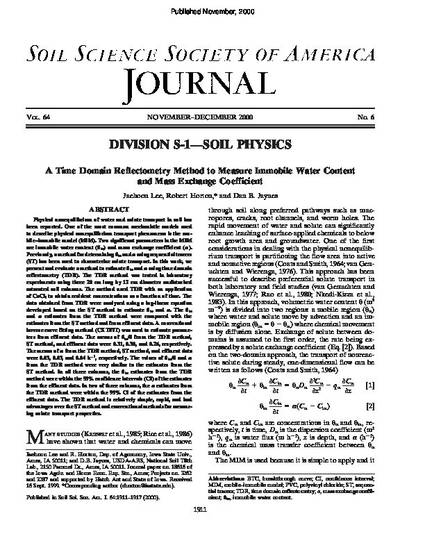
Physical nonequilibrium of water and solute transport in soil has been reported. One of the most common mechanistic models used to describe physical nonequilibrium transport phenomena is the mobile–immobile model (MIM). Two significant parameters in the MIM are immobile water content (θim) and mass exchange coefficient (α). Previously, a method for determining θim and α using sequential tracers (ST) has been used to characterize solute transport. In this work, we present and evaluate a method to estimate θim and α using time domain reflectometry (TDR). The TDR method was tested in laboratory experiments using three 20 cm long by 12 cm diameter undisturbed saturated soil columns. The method used TDR with an application of CaCl2 to obtain resident concentrations as a function of time. The data obtained from TDR were analyzed using a log-linear equation developed based on the ST method to estimate θim and α. The θim and α estimates from the TDR method were compared with the estimates from the ST method and from effluent data. A conventional inverse curve fitting method (CXTFIT) was used to estimate parameters from effluent data. The means of θim/θ from the TDR method, ST method, and effluent data were 0.31, 0.30, and 0.26, respectively. The means of α from the TDR method, ST method, and effluent data were 0.03, 0.03, and 0.04 h−1, respectively. The values of θim/θ and α from the TDR method were very similar to the estimates from the ST method. In all three columns, the θim estimates from the TDR method were within the 95% confidence intervals (CI) of the estimates from the effluent data. In two of three columns, the α estimates from the TDR method were within the 95% CI of the estimates from the effluent data. The TDR method is relatively simple, rapid, and had advantages over the ST method and conventional methods for measuring solute transport properties.
Available at: http://works.bepress.com/robert-horton/92/

This article is published as Lee, Jaehoon, Robert Horton, and Dan B. Jaynes. "A time domain reflectometry method to measure immobile water content and mass exchange coefficient." Soil Science Society of America Journal 64, no. 6 (2000): 1911-1917. doi: 10.2136/sssaj2000.6461911x. Posted with permission.